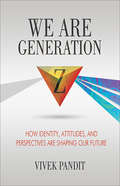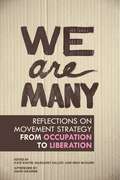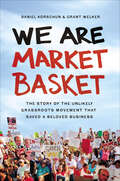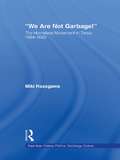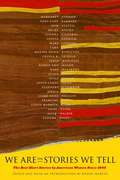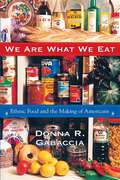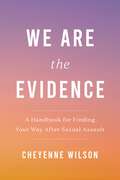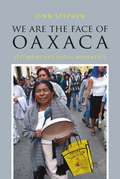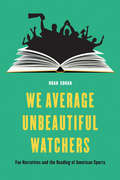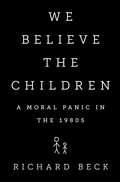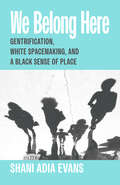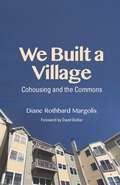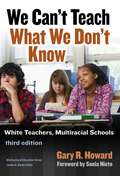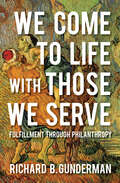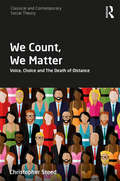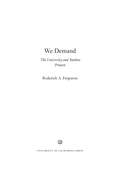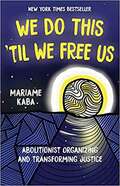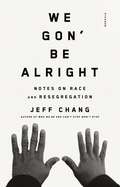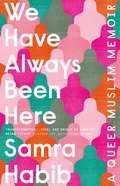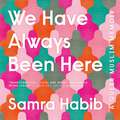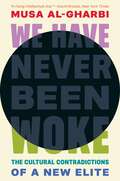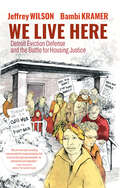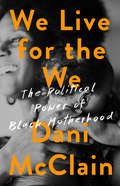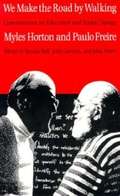- Table View
- List View
We Are Generation Z: How Identity, Attitudes, and Perspectives Are Shaping Our Future
by Vivek PanditA young author shares an insider’s perspective on what it means to be Generation Z—and what Generation Z means for the world.Born at the turn of the millennium, the members of Generation Z are no strangers to today’s fast-paced, hyperconnected world. They were born in the Digital Age. They grew up online. Their identities, attitudes, and perspectives have all been uniquely integrated with technology. Now, as they stand at the brink of adulthood, it’s time for the world to discover: Who is Generation Z?Vivek Pandit understands firsthand what it means to be a digital native, and he has a unique view of the road ahead. By exploring the forces that have shaped him and his peers, he gives insight into how they may go on to shape the world.Winner of the Moonbeam Children’s Book Award Gold Medal in the Youth Author (under 18) category
We Are Many
by David Graeber Kate Khatib Mike Mcguire Margaret Killjoy"A wonderful collection of questions and reflections on the state of the movement today, where we came from, and where we might be going. It is all too rare that in the process of creating the movement and living the moment, participants and thinkers step back and ask the most pressing questions. This book is an important step." Marina Sitrin, Occupy Wall Street organizer and author of HorizontalismWe have all been swept up by the momentum of the Occupy movement. We have seen the results of years of organizing in different communities come together in ways that few could have imagined, bolstered by the scores of people who have left the comfort of their daily routine behind and taken to the streets. Yet as a movement so overflowing with new social and political actors, we lack the framework we need to help us all to understand what a social movement is, to understand how change has happened in the past, to understand what this moment means and what this movement makes possible.We Are Many is a reflection on Occupy from within the heart of the movement itself. Examining key questions: What worked? What didn't? Why? How? Is it reproducible? The authors and activists in this collection point toward a movement-based framework for future organizing. Heavily illustrated and annotated, We Are Many is a celebration of what worked, and a thoughtful analysis of what didn't.Contributors:Michael Andrews, Michael Belt, Nadine Bloch, Rose Bookbinder, Mark Bray, Emily Brissette, George Caffentzis, George Ciccariello-Maher, Annie Cockrell, Joshua Clover, Andy Cornell, Molly Crabapple, CrimethInc., Croatoan, Paul Dalton, Chris Dixon, John Duda, Brendan M. Dunn, Lisa Fithian, Gabriella, David Graeber, Ryan Harvey, Gabriel Hetland, Marisa Holmes, Mike King, Koala Largess, Yvonne Yen Liu, Josh MacPhee, Manissa M. Maharawal, Yotam Marom, Cindy Milstein, Occupy Research, Joel Olson, Isaac Ontiveros, Morrigan Phillips, Frances Fox Piven, Vijay Prashad, Michael Premo, Max Rameau, RANT, Research & Destroy, Nathan Schneider, Jonathan Matthew Smucker, Some Oakland Antagonists, Lester Spence, Janaina Stronzake, Mattilda Bernstein Sycamore, Team Colors Collective, Janelle Treibitz, Unwoman, Immanuel Wallerstein, Sophie Whittemore, Kristian Williams, and Jaime Omar Yassin.
We Are Market Basket: The Story of the Unlikely Grassroots Movement That Saved a Beloved Business
by Daniel Korschun Grant WelkerWhat if a company were so treasured and trusted that people literally took to the streets—by the thousands—to save it? That company is Market Basket, a popular New England supermarket chain.With its arresting firsthand accounts from the streets and executive suites, We Are Market Basket is as inspiring as it is instructive. What is it about Market Basket and its leader that provokes such ferocious loyalty? How does a company spread across three states maintain a culture that embraces everyone—from cashier to customer—as family? Can a company really become an industry leader by prioritizing stakeholders over shareholders?After long-time CEO Arthur T. Demoulas was ousted by his cousin Arthur S. Demoulas, the company's managers and rank-and-file workers struck back. Risking their own livelihoods to restore the job of their beloved boss they walked out, but they didn't walk far.The national media and experts were stunned by the unprecedented defense of an executive.All openly challenged the Market Basket board of directors to make things right. In the end:They were joined by loyal customers at protest rallies—leaving stores empty.Suppliers and vendors stopped deliveries—rendering shelves bare.Politicians were forced to take sides.Set against a backdrop of bad blood and corporate greed, We Are Market Basket is a page-turner that chronicles the epic rise, fall, and redemption of this iconic and uniquely American company.Note: There are links to media content within the text of this EBook which may not work on all reading devices.
We Are Not Garbage!: The Homeless Movement in Tokyo, 1994-2002 (East Asia: History, Politics, Sociology and Culture)
by Miki HasegawaThis book offers a full history of a homeless movement in Tokyo that lasted nearly a decade. It shows how homeless people and their external supporters in the city combined their scarce resources to generate and sustain the movement. The study advocates a more nuanced analysis of movement gains to appreciate how poor people can benefit by acting collectively. It also draws attention to potential difficulties faced by lower-stratum movements aided by external allies. In particular, the study highlights how actions of the state can undermine the relations between aggrieved allies in such a way as to limit gains. The book is the first in English to detail homeless mobilization in Japan. It also addresses the origins of increased homelessness and development of homelessness policy in the country. Besides homelessness, it covers a number of current social issues, including economic globalization, social exclusion, and politics over space.
We Are The Stories We Tell
by Wendy Martin Ed.A collection of 26 of the finest stories by the finest women writers tocome out of the U. S. and Canada in the past 50 years. Authors include Ann Beattie, Ann Tyler, Tama Janowitz and Alice Walker.
We Are What We Eat: Ethnic Food and the Making of Americans
by Donna R. GabacciaGhulam Bombaywala sells bagels in Houston. Demetrios dishes up pizza in Connecticut. The Wangs serve tacos in Los Angeles. How ethnicity has influenced American eating habits--and thus, the make-up and direction of the American cultural mainstream--is the story told in We Are What We Eat. It is a complex tale of ethnic mingling and borrowing, of entrepreneurship and connoisseurship, of food as a social and political symbol and weapon--and a thoroughly entertaining history of our culinary tradition of multiculturalism. The story of successive generations of Americans experimenting with their new neighbors' foods highlights the marketplace as an important arena for defining and expressing ethnic identities and relationships. We Are What We Eat follows the fortunes of dozens of enterprising immigrant cooks and grocers, street hawkers and restaurateurs who have cultivated and changed the tastes of native-born Americans from the seventeenth century to the present. It also tells of the mass corporate production of foods like spaghetti, bagels, corn chips, and salsa, obliterating their ethnic identities. The book draws a surprisingly peaceful picture of American ethnic relations, in which "Americanized" foods like Spaghetti-Os happily coexist with painstakingly pure ethnic dishes and creative hybrids. Donna Gabaccia invites us to consider: If we are what we eat, who are we? Americans' multi-ethnic eating is a constant reminder of how widespread, and mutually enjoyable, ethnic interaction has sometimes been in the United States. Amid our wrangling over immigration and tribal differences, it reveals that on a basic level, in the way we sustain life and seek pleasure, we are all multicultural.
We Are the Evidence: A Handbook for Finding Your Way After Sexual Assault
by Cheyenne WilsonA necessary, reassuring guide for all sexual assault survivors in need of immediate emotional and legal support post assault, and in the months and years after.We Are the Evidence is the first comprehensive resource for survivors of sexual assault. Written with conviction and compassion by Cheyenne Wilson, a registered nurse and survivor of sexual assault, this handbook contains everything victims and advocates need to know to navigate the tumultuous times that follow an assault. Within, there's advice for: The appropriate steps to take immediately after an assault Disclosing your assault how and when you choose How to pursue justice and navigate the legal system Beginning the healing process and reclaiming your power Throughout, you'll find exercises, opportunities to rest, and invaluable guidance from experts like attorneys, detectives and therapists. Voices from other sexual assault survivors also lend their support. Meant to be easily accessible, everything is organized for you to go right to the topic you most need guidance for, no matter where you are on your healing journey. You deserve to be heard, believed, and supported.
We Are the Face of Oaxaca: Testimony and Social Movements
by Lynn StephenA massive uprising against the Mexican state of Oaxaca began with the emergence of the Popular Assembly of the Peoples of Oaxaca (APPO) in June 2006. A coalition of more than 300 organizations, APPO disrupted the functions of Oaxaca's government for six months. It began to develop an inclusive and participatory political vision for the state. Testimonials were broadcast on radio and television stations appropriated by APPO, shared at public demonstrations, debated in homes and in the streets, and disseminated around the world via the Internet. The movement was met with violent repression. Participants were imprisoned, tortured, and even killed. Lynn Stephen emphasizes the crucial role of testimony in human rights work, indigenous cultural history, community and indigenous radio, and women's articulation of their rights to speak and be heard. She also explores transborder support for APPO, particularly among Oaxacan immigrants in Los Angeles. The book is supplemented by a website featuring video testimonials, pictures, documents, and a timeline of key events.
We Average Unbeautiful Watchers: Fan Narratives and the Reading of American Sports (Sports, Media, and Society)
by Noah CohanSports fandom—often more than religious, political, or regional affiliation—determines how millions of Americans define themselves. In We Average Unbeautiful Watchers, Noah Cohan examines contemporary sports culture to show how mass-mediated athletics are in fact richly textured narrative entertainments rather than merely competitive displays. While it may seem that sports narratives are “written” by athletes and journalists, Cohan demonstrates that fans are not passive consumers but rather function as readers and writers who appropriate those narratives and generate their own stories in building their sense of identity. Critically reading stories of sports fans’ self-definition across genres, from the novel and the memoir to the film and the blog post, We Average Unbeautiful Watchers recovers sports games as sites where fan-authors theorize interpretation, historicity, and narrative itself. Fan stories demonstrate how unscripted sporting entertainments function as identity-building narratives—which, in turn, enhances our understanding of the way we incorporate a broad range of texts into our own life stories. Building on the work of sports historians, theorists of fan behavior, and critics of American literature, Cohan shows that humanistic methods are urgently needed for developing nuanced critical conversations about athletics. Sports take shape as stories, and it is scholars in the humanities who can best identify how they do so—and why that matters for American culture more broadly.
We Believe the Children: A Moral Panic in the 1980s
by Richard BeckIn the 1980s in California, New Jersey, and New York, Michigan, Massachusetts, and Florida, Tennessee, Texas, Ohio, and elsewhere, daycare workers were arrested, charged, tried, and convicted of committing horrible sexual crimes against the children they cared for. These crimes, prosecutors said, had gone undetected for years, and their brutality and sadism defied all imagining. What’s more, the abusers had photographed and videotaped their victims, distributing the images through a sophisticated international network of child pornographers. More often than not, violent satanic cult worship had also played a central role, with children made to watch forced abortions in cemeteries and then eat hacked-off bits of the little corpses. In just over a decade, thousands of people in every part of the country were investigated as child sex abusers, and some one-hundred and fifty of them were sent to prison. But, none of it happened. It was an epic decade-long outbreak of collective hysteria - on a par with the Salem witch trials or the red scares of the 1950s. Using extensive archival research conducted in Los Angeles, Miami, New York, and elsewhere, and drawing on dozens of interviews conducted with the hysteria’s major figures, Richard Beck shows how a group of legislators, doctors, lawyers, and parents, all working with the best of intentions, set the stage for a judicial disaster. A number of opportunistic journalists helped to carry the story from state to state, and the silence of their colleagues, who should have known better, allowed it to keep spreading long after it became clear that the story was simply unsupported by evidence. Beck reveals how a small group of skeptics finally began working to slow the runaway train in the last half of the decade, and he explores the fates of those accused and convicted of these unbelievable crimes, the casualties of a culture war. It is this culture war that is the books pervasive subtext - the conditions that made possible the demented frenzy of accusations were very specific, and at the root of them were competing visions of society and the things that threatened it most.
We Belong Here: Gentrification, White Spacemaking, and a Black Sense of Place
by Shani Adia EvansA landmark study that shows how Black residents experience and respond to the rapid transformation of historically Black places. Although Portland, Oregon, is sometimes called “America’s whitest city,” Black residents who grew up in the neighborhoods of northeast Portland have made it their own. The district of Albina, also called “Northeast,” was their haven and a hub of Black community life. But between 1990 and 2010, Albina changed dramatically—it became majority white. In We Belong Here, sociologist Shani Adia Evans offers an intimate look at gentrification from the inside, documenting the reactions of the residents of Albina as the racial demographics of their neighborhood shift. As white culture becomes centered in Northeast, Black residents recount their experiences with what Evans refers to as “white watching,” the questioning look on the faces of white people they encounter, which conveys an exclusionary message: “What are you doing here?” This, Evans shows, is a prime example of what she calls “white spacemaking”: the establishment of white space—spaces in which whiteness is assumed to be the norm—in formerly non-white neighborhoods. While gentrification typically describes socioeconomic changes that may have racial implications, white spacemaking allows us to understand racism as a primary mechanism of neighborhood change. We Belong Here illuminates why gentrification and white spacemaking should be examined as intersecting, but not interchangeable, processes of neighborhood change.
We Built a Village: Cohousing and the Commons
by Diane Rothbard MargolisDescribes the development of one of the first cohousing communities in the U.S. offering a social understanding of its commons.Cohousing, a form of communal living that clusters around shared common space, began about a half century ago in Denmark. We Built a Village describes the process of planning and building of an early cohousing community in Cambridge, Massachusetts, and the way the people involved simultaneously built their homes and their social structure. As both a memoir and a sociological analysis that probes the differences between commons and markets, it is unique among books about cohousing. When this group of people began in the late 1990s to construct their cohousing community, they set in motion a counterpoint between the physical spaces and the social configurations that would guide their lives together, even up to creative responses to the recent pandemic.
We Can't Teach What We Don't Know
by Sonia Nieto Gary R. HowardFor author Gary Howard, the issues and passions that sparked the writing of the first edition of this now classic work are as intense today as they were then. In the Third Edition, Howard reviews the progress that has been made in the interim (for example, the first Black president in the White House), as well as the lack of progress (the gutting of the 1965 Voting Rights Act, the epidemic of Black youth killed by police, the persistence of race-based educational disparities). Making a case for the "fierce urgency of now" this new edition deepens the discussion of race and social justice in education with new and updated material. Aligned with the United States' ever more diverse student population, it speaks to what good teachers know, what they do, and how they embrace culturally responsive teaching. This essential text is widely used in teacher preparation courses and for in-service professional development. New for the third edition is: a revised introduction that places the book in the context of the 50th anniversay of the 1963 march on Washington; an updated analysis of White social dominance, bringing in the Critical Race Theory and reflecting on the racist reaction to the election of the first US Black President; more detail to the White Identity Orientations model; a new section "The Whiteness of School Reform", demonstrating how White social dominance drives much of the corporate school reform movement; a rich discussion of the seven principles for Culturally Responsive Teaching, and an expanded Reflection and Discussion Guide authored by two educators who have been using the book in professional development sessions for many years.
We Come to Life with Those We Serve: Fulfillment through Philanthropy
by Richard B. GundermanA study of how philanthropy can enrich our lives, as shown by examples from both the lives of real-life individuals and fictional characters.What is the most meaningful and rewarding path in life? Many assume we enrich ourselves only by accumulating more wealth, power, and fame, or by finding new and greater forms of pleasure. In reality, we are most enriched not in taking from others but in sharing the best we have to offer through a life of service. The legendary, real-life individuals and the famous literary characters in this inspiring book show us the way: Vincent Van Gogh exemplified service through art, Benjamin Franklin dedicated his life to service of community, and the career of coach John Wooden is apt testimony to the rewards of service through education. Gunderman persuasively argues that, far from draining away our vitality, service at its best actually brings us to life.
We Count, We Matter: Voice, Choice and the Death of Distance (Classical and Contemporary Social Theory)
by Christopher SteedThis book examines the meaning of Brexit, the election of Trump and the rising tide of populist revolt on the right amidst the collapse of the left. Exploring the reaction against the establishment or ‘the system’, the author contends that we are witnessing a new divide between those who wish to see an interconnected world and those who seek distance: as transport and technology shrink the world, we witness a backlash that favours protectionism and opposes immigration. Distance is the new frontier: for some, remote players are rejected in favour of identities closer to home. This divide plays out in relation to the notion of ‘face’, as individuals react to ‘faceless’ organisations and processes such as globalisation and automation, responding to a sense of alienation on social media and developing a conception of themselves as networked individuals. Thus, we move towards a type of society characterised not by honour and dishonour, or right and wrong, but by voice and choice. A fascinating and very accessible analysis of the divisions and transformations that have come to dominate the contemporary landscape, this book will appeal to political leaders and social scientists with interests in globalisation, social movements and social theory.
We Demand: The University and Student Protests
by Roderick A. FergusonThis title is part of American Studies Now and available as an e-book first. Visit ucpress.edu/go/americanstudiesnow to learn more. In the post–World War II period, students rebelled against the archaic university. In student-led movements, they fought for the new kinds of public the university needed to serve—women, minorities, immigrants, indigenous people, and more—with a success that had a profound impact on the intellectual landscape of the twentieth century. Because of their efforts, ethnic studies, women’s studies, and American studies were born, and minority communities have become more visible and important to academic debate. Less than fifty years since this pivotal shift in the academy, however, the university is fighting back. In We Demand, Roderick A. Ferguson shows how the university, particularly the public university, is moving away from “the people” in all their diversity. As more resources are put toward STEM education, humanities and interdisciplinary programs are being cut and shuttered. This has had a devastating effect on the pursuit of knowledge, and on interdisciplinary programs born from the hard work and effort of an earlier generation. This is not only a reactionary move against the social advances since the ’60s and ’70s, but part of the larger threat of anti-intellectualism in the United States.
We Do This 'til We Free Us: Abolitionist Organizing and Transforming Justice (Abolitionist Papers)
by Mariame Kaba Tamara K. Nopper Naomi MurakawaWhat if social transformation and liberation isn’t about waiting for someone else to come along and save us? What if ordinary people have the power to collectively free ourselves? In this timely collection of essays and interviews, Mariame Kaba reflects on the deep work of abolition and transformative political struggle. <p><p> With a foreword by Naomi Murakawa and chapters on seeking justice beyond the punishment system, transforming how we deal with harm and accountability, and finding hope in collective struggle for abolition, Kaba’s work is deeply rooted in the relentless belief that we can fundamentally change the world. As Kaba writes, “Nothing that we do that is worthwhile is done alone.”
We Gave Away a Fortune
by Christopher Mogil Anne Slepian Peter WoodrowStories of People Who Have Devoted Themselves and Their Wealth To Peace, Justice and a Healthy Environment
We Gon' Be Alright: Notes on Race and Resegregation
by Jeff ChangIn these provocative, powerful essays acclaimed writer/journalist Jeff Chang (Can’t Stop Won’t Stop, Who We Be) takes an incisive and wide-ranging look at the recent tragedies and widespread protests that have shaken the country. Through deep reporting with key activists and thinkers, passionately personal writing, and distinguished cultural criticism, this book links #BlackLivesMatter to #OscarsSoWhite, Ferguson to Washington D.C., the Great Migration to resurgent nativism. Chang explores the rise and fall of the idea of “diversity,” the roots of student protest, changing ideas about Asian Americanness, and the impact of a century of racial separation in housing. He argues that resegregation is the unexamined condition of our time, the undoing of which is key to moving the nation forward to racial justice and cultural equity.
We Have Always Been Here
by Samra HabibTriumphant and uplifting - a queer Muslim memoir about forgiveness and freedom.'Revolutionary' Mona Eltahawy * 'Exquisite, powerful and urgent' Stacey May Fowles * 'I fell in love with this book' Shani MootooA memoir of hope, faith and love, Samra Habib's story starts with growing up as part of a threatened minority sect in Pakistan, and follows her arrival in Canada as a refugee, before escaping an arranged marriage at sixteen. When she realized she was queer, it was yet another way she felt like an outsider. So begins a journey that takes her to the far reaches of the globe to uncover a truth that was within her all along. It shows how Muslims can embrace queer sexuality, and families can embrace change. A triumphant story of forgiveness and freedom, We Have Always Been Here is a rallying cry for anyone who has ever felt alone and a testament to the power of fearlessly inhabiting one's truest self.
We Have Always Been Here
by Samra HabibA powerful, uplifting queer Muslim memoir by a young Pakistani-Canadian activist and photographer.Triumphant and uplifting - a queer Muslim memoir about forgiveness and freedom.A memoir of hope, faith and love, Samra Habib's story starts with growing up as part of a threatened minority sect in Pakistan, and follows her arrival in Canada as a refugee, before escaping an arranged marriage at sixteen. When she realized she was queer, it was yet another way she felt like an outsider. So begins a journey that takes her to the far reaches of the globe to uncover a truth that was within her all along. It shows how Muslims can embrace queer sexuality, and families can embrace change. A triumphant story of forgiveness and freedom, We Have Always Been Here is a rallying cry for anyone who has ever felt alone and a testament to the power of fearlessly inhabiting one's truest self.(P) 2019 Quercus Editions Limited
We Have Never Been Woke: The Cultural Contradictions of a New Elite
by Musa al-GharbiHow a new &“woke&” elite uses the language of social justice to gain more power and status—without helping the marginalized and disadvantagedSociety has never been more egalitarian—in theory. Prejudice is taboo, and diversity is strongly valued. At the same time, social and economic inequality have exploded. In We Have Never Been Woke, Musa al-Gharbi argues that these trends are closely related, each tied to the rise of a new elite—the symbolic capitalists. In education, media, nonprofits, and beyond, members of this elite work primarily with words, ideas, images, and data, and are very likely to identify as allies of antiracist, feminist, LGBTQ, and other progressive causes. Their dominant ideology is &“wokeness&” and, while their commitment to equality is sincere, they actively benefit from and perpetuate the inequalities they decry. Indeed, their egalitarian credentials help them gain more power and status, often at the expense of the marginalized and disadvantaged.We Have Never Been Woke details how the language of social justice is increasingly used to justify this elite—and to portray the losers in the knowledge economy as deserving their lot because they think or say the &“wrong&” things about race, gender, and sexuality. Al-Gharbi&’s point is not to accuse symbolic capitalists of hypocrisy or cynicism. Rather, he examines how their genuine beliefs prevent them from recognizing how they contribute to social problems—or how their actions regularly provoke backlash against the social justice causes they champion.A powerful critique, We Have Never Been Woke reveals that only by challenging this elite&’s self-serving narratives can we hope to address social and economic inequality effectively.
We Live Here: Detroit Eviction Defense and the Battle for Housing Justice
by Jeffrey Wilson Bambi KramerA graphic novel featuring uplifting stories of combatting—and beating—calls for their eviction in Detroit, showing how everyday people are fighting to stay in their homes, organizing with their communities, and winning.We Live Here! is a graphic novel biography of the members of the local activist group Detroit Eviction Defense combatting—and beating—calls for their eviction. By illustrating the stories of families struggling against evictions, the book gives a voice to those who have remained in Detroit, showing the larger complexities at work in a beleaguered city. These are everyday people fighting back, organizing with others, going into the streets, and winning their homes back. What will Detroit look like in the future? Today cheap property entices real estate speculators from around the world. Artists arrive from all over viewing the city as a creative playground. Billionaires are re-sculpting downtown as a spot for tourism. But beyond the conventional players in urban growth and development, Detroit Eviction Defense (DED) members—like others engaged in place-based struggles all over the country—are pushing back, saying in effect, &“we live here, we&’ve been here, there is no Detroit without us.&”
We Live for the We: The Political Power of Black Motherhood
by Dani McClainA warm, wise, and urgent guide to parenting in uncertain times, from a longtime reporter on race, reproductive health, and politicsIn We Live for the We, first-time mother Dani McClain sets out to understand how to raise her daughter in what she, as a black woman, knows to be an unjust--even hostile--society. Black women are more likely to die during pregnancy or birth than any other race; black mothers must stand before television cameras telling the world that their slain children were human beings. What, then, is the best way to keep fear at bay and raise a child so she lives with dignity and joy?McClain spoke with mothers on the frontlines of movements for social, political, and cultural change who are grappling with the same questions. Following a child's development from infancy to the teenage years, We Live for the We touches on everything from the importance of creativity to building a mutually supportive community to navigating one's relationship with power and authority. It is an essential handbook to help us imagine the society we build for the next generation.
We Make the Road by Walking: Conversations on Education and Social Change
by Myles Horton Paulo Freire Brenda Bell John Gaventa John PetersIn December 1987, Myles Horton and Paulo Freire, two pioneers of education for social change, came together to "talk a book" about their experiences and ideas. Though they came from different environments--one from the rural mountains of Appalachia, the other from São Paulo, the largest industrial city in Brazil--Myles and Paulo shared a vision and a history of using participatory education as a crucible for empowerment of the poor and powerless.
